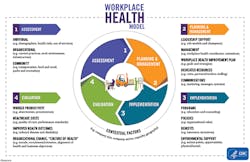What's Your Incentive?
A child's laughter rings through the air as she chases other children around the neighborhood. A boy confidently throws a ball into a hoop at the playground down the street.
While these activities may have been commonplace as recent as 20 years ago, they are no longer the norm.
Technology advancements have created a more sedentary lifestyle, leading to a rise in obesity and health care costs. In addition, gym memberships and pay-to-pay programs increasingly have become cost-prohibitive to much of the population.
"If you're one of the active people, you'll say ‘I’ll head to the gym." You have to pay to get that activity in," says Bill Sells, vice president for government relations, Sports and Fitness Industry Association (SFIA). "It's going to come with a cost. Being active today has a price tag attached where it did not have a price tag attached in previous generations."
However, despite widespread awareness of the benefits of an active, healthy lifestyle, companies are finding it difficult to encourage a culture of wellness without the use of incentives.
"Employees that are actively involved in wellness initiatives are less likely to leave, are more productive and are much less prone to absenteeism," says Dean Debnam, CEO of Workplace Options. "All of these items directly benefit an organization's bottom line. Employee well-being is something that's too important to overlook from both a management and a performance standpoint. "
A Culture of Wellness
Corporate wellness programs are designed for mutual benefit – when employees win, employers win and the business as a whole flourishes, Debnam says.
"It's important to stress that when thinking about wellness or well-being, it's important to move beyond physical exercise and nutrition," he says. "Successful companies don't just help their employees exercise and lose weight so they get sick less often; they help people address the issues that impact their emotional, physical and practical well-being. We don't live in a world anymore where work is work and home is home. Life is integrated, and successful support for employees has to be as well."
The way to bridge this gap is to make progress on both sides, and companies have the opportunity to do that with health and wellness initiatives. However, keeping employees on track can be a challenge without some type of "economic incentive," according a 2014 study from the Centers for Disease Control and Prevention.
"If you provide an incentive, people will usually participate at the minimum level needed to receive whatever you are giving away or making available," Debnam says. "Wellness programs deliver the highest return when employees see them as valuable additions to their lives, not necessarily as an avenue to a discounted insurance premium or the gateway to a new Fitbit. The challenge is creating a culture where wellness and well-being are seen as a positive thing, even a necessity among employees."
Gift cards, cash prizes and other tangible options most commonly are used for corporate wellness programs. Intangibles could include something as simple as recognition for achievement in the form of a reserved parking spot, says David Roddenberry, HealthyWage co-founder.
Once workers are engaged, this significantly can change a company's work dynamic, culture and bottom line.
"The crux of the solution is that we're all bombarded with education. We know what we need to do," Roddenberry says. "It's a motivation problem. How do you re-engineer the solution so that you get people engaged? People know what they need to do but they're not doing it."
Pre-Tax Benefits
Companies aren't the only entities looking to battle the obesity epidemic and lower health-care costs. The government also is searching for ways to incentivize fitness activities across the nation.
A new bill reintroduced to Congress on March 1 could give corporate wellness programs the boost they need to gain more participants and improve worker health.
The Personal Health Investment Today (PHIT) Act is a bi-partisan-supported proposal that would allow medical account tax deductions to be applied to some specified costs associated with staying active.
Currently, pre-tax medical accounts provided by employers allow a worker to take part of their earnings and place it into a special account for out-of-pocket expenses such as hospital visits and bills.
The PHIT legislation would make it possible for the average American to utilize that account for health prevention activities such as sports league fees, fitness trackers, gym memberships and equipment.
The limit for qualified sports and fitness expenses for any taxable year would total $1,000 for an individual or $2,000 in the case of a joint return or head of household.
"What we've found is we have a decline in participation – cost is a major barrier," Sells says. "We said ‘what can we do to help families and young people just entering the workforce that don't have a lot of money with the costs?'"
American society has prioritized convenience, especially when it comes to errands such as shopping. In the past, a person would go to the mall and walk to numerous stores for one product, actively seeking the best price. Now, that same person could save hours by shopping online, Sells says.
"All the key people that we need to support this are behind us. We are the only HSA expansion bill with both Democrats and Republicans on it," he says. "Now it's just a matter of getting the word out, getting the public engaged, letting Congress know that they want this and finding the right vehicle in Congress to attach the PHIT bill to so its gets passed as part of a broader health care package."

